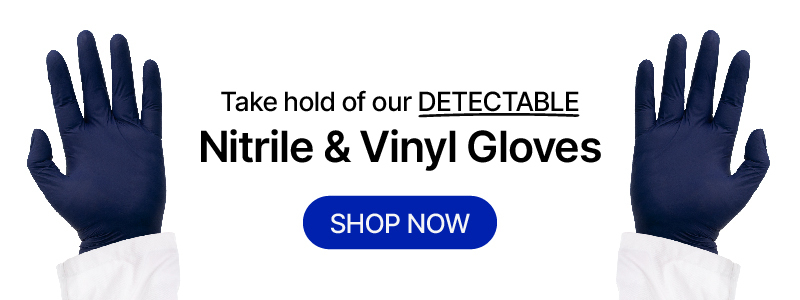Common PPE mistakes in food processing & how to avoid them

Personal Protective Equipment (PPE) is a critical component in ensuring the safety of both your workers and your consumers, as well as for maintaining the integrity of your products. However, misuse and misunderstanding of PPE can lead to contamination, injury and regulatory non-compliance.
So, let’s look at some of the more common PPE mistakes in food processing and provide practical tips on how to avoid them.
Basic principles of PPE in food processing
Let’s start with the essentials for effective PPE management in food manufacturing settings:
1. Adequate training
Mistake: Workers may not fully understand why PPE is important or how to use it correctly.
Solution: Implement comprehensive training programmes that cover the importance of PPE, how to wear it correctly and when to replace it. Regular refresher courses can help reinforce these concepts.
2. Proper fitting
Mistake: Ill-fitting PPE can be uncomfortable which can lead workers to use it improperly or even to abandon using it, which compromises safety and hygiene.
Solution: Ensure that PPE is available in various sizes and fits well. Conduct regular fit tests, especially for masks and gloves, to ensure they provide the necessary protection.
3. Consistent use
Mistake: If workers don’t understand the value of PPE, they may not wear it consistently, especially if they find it uncomfortable or if they believe the risk is low.
Solution: Encourage a culture of safety where everyone understands the importance of consistent PPE use. Then, back this up by enforcing strict PPE policies and conducting regular audits to ensure compliance.
4. Avoid cross-contamination
Mistake: Sharing or reusing PPE without proper cleaning can lead to cross-contamination, especially in environments where different types of food are processed.
Solution: Ensure you have sufficient supplies so everyone who needs clean PPE can get it. Establish clear protocols for cleaning and storing PPE. Also, using colour-coded PPE can differentiate between areas or tasks to minimise the risk of cross-contamination.
5. Proper disposal
Mistake: Disposing of used PPE improperly can lead to hygiene risks, environmental contamination and regulatory violations.
Solution: Provide designated disposal bins for used PPE and train workers on proper disposal methods. Ensure that all waste is handled according to appropriate local regulations.
6. Maintenance
Mistake: Neglecting the maintenance of PPE can render it ineffective over time.
Solution: Implement a maintenance schedule for PPE, including regular inspections and replacements as needed. Keep records of PPE maintenance to ensure accountability.
7. Prioritise comfort
Mistake: Uncomfortable PPE can lead to physical discomfort which can reduce a worker’s productivity, it could also result in non-compliance.
Solution: Invest in high-quality, comfortable PPE that meets industry standards. Consider worker feedback when selecting PPE to ensure it is both effective and comfortable. Embrace your duty of care to ensure their employees are comfortable at work.
8. Personalisation
Mistake: One-size-fits-all approaches to PPE can be ineffective, as different workers may have different needs and physical attributes.
Solution: Tailor PPE to the individuals using it, where possible. For example, offering Nitrile or Vinyl types of gloves for workers who may experience allergic reactions to latex.
9. Communication
Mistake: Poor communication can lead to misunderstandings and non-compliance with PPE policies. This can lead to contamination hazards and decreased efficiency.
Solution: Foster open communication channels where workers are updated on relevant information and can, in return, ask questions and provide feedback. Use visual aids, such as posters and signs, to remind workers of PPE requirements.
10. Foreign matter contamination from PPE
Mistake: Poorly maintained, improperly used or out-of-date PPE can, itself, become a foreign matter contaminant.
Solution: Regularly refresh your supply of PPE and purchase high-quality detectable PPE so, if an incident of foreign matter contamination happens, you can detect and remove the contaminant before it leaves your facility.
Specific types of PPE, common mistakes & best practices
Below, we outline some of the more common PPE products used in food processing. We then detail some of the specific mistakes made with these PPE products, and the best practices to prevent the mistakes.
Gloves
Gloves act as a barrier, preventing direct contact between hands and food products, which helps reduce the risk of contamination. Additionally, gloves protect workers from exposure to extreme temperatures and to hazardous substances, such as cleaning agents or raw materials that may cause allergic reactions or irritations.
Common Mistakes:
Improper Fit: Ill-fitting gloves reduce dexterity and can tear or slip off, posing contamination risks.
Reusing Disposable Gloves: Disposable gloves are meant for single use; reusing them can create cross-contamination threats for products or areas.
Using Non-Detectable Gloves: In the event of glove material tearing loose and entering the food workflow, non-detectable material can be nearly impossible to trace, creating a contamination hazard.
Best Practices:
Ensure Proper Fit: Offer gloves in various sizes and ensure workers select the correct size.
Enforce Single-Use Policy: Establish a strict policy that disposable gloves are single-use only, particularly when switching between tasks.
Use Detectable Gloves: Detectamet’s Metal Detectable Nitrile and Vinyl gloves are designed for food safety environments, allowing easy detection if fragments are lost.
Face Masks
Face masks prevent the transfer of airborne contaminants, such as droplets from coughing or sneezing, into food products. Face masks can also help to protect workers from airborne hazards, such as dust or chemical particles.
Common Mistakes:
Improper Fit: Loose or improperly fitted face masks may not cover the nose and mouth completely, reducing their effectiveness.
Inconsistent Use: Masks may not be worn consistently, particularly in lower-risk areas where they are still essential to prevent contamination.
Using Non-Detectable Masks: Non-detectable masks can pose a contamination risk if fragments tear off, especially in high-contact areas.
Best Practices:
Ensure Proper Fit: Provide masks that fit comfortably yet securely, covering both the nose and mouth completely.
Mandatory Usage Policy: Enforce mask usage in all relevant areas and train staff on consistent use to avoid contamination risks.
Choose Detectable Masks: Detectamet offers metal detectable face masks and coverings that help add a level of detectability to your food safety protocols if any fragments are lost.
Mob Caps, Hairnets and Beard Snoods
PPE headwear prevents stray hairs from contaminating food products, helping to maintain a hygienic environment.
Common Mistakes:
Improper Use: Improperly secured caps, hairnets or beard snoods may not fully cover the hair, allowing strands to escape and find their way into the food product. They may also be uncomfortable which may lead to inconsistent use.
Inconsistent Use: Sometimes, hairnets and beard snoods aren’t worn in all necessary areas, risking contamination.
Using Non-Detectable Headwear: In the event a cap or net falls off, it can become a contaminant itself if it - or part of it - finds its way into the processing machinery.
Best Practices:
Proper Use: Ensure all staff are trained in the importance of headwear and understand the proper usage of any hair or facial coverings.
Mandatory Use Policy: Enforce hair and beard nets in all food production areas, from prep to packaging, to prevent accidental contamination.
Use Detectable Mob-Caps, Hairnets and Beard Snoods: Detectamet’s DetectaNet range of headwear is secure, comfortable and metal detectable. As is our range of mesh and non-woven beard snoods here.
Aprons
Aprons protect both clothing and skin from potential contaminants in food production areas.
Common Mistakes:
Inadequate Cleaning and Maintenance: Reusing unclean aprons can spread contaminants from one area to another.
Failure to Use Detectable Aprons: Non-detectable aprons pose a contamination risk if any material tears off during use.
Best Practices:
Implement Regular Cleaning Protocols: Set a standard for the frequent cleaning of reusable aprons and a ready supply of disposable aprons to ensure cleanliness, especially in high-contact areas.
Use Detectable Aprons: Detectamet offers a range of detectable aprons, in a choice of colours to help with your HACCP protocols.
Earplugs
Ear protection is vital in noisy food processing environments, ensuring worker hearing protection without compromising food safety.
Common Mistakes:
Improper Fit: Poorly fitted earplugs might fail to provide adequate protection and they can easily fall out during work, making them a contamination hazard.
Neglecting Detectability: Because they are small, non-detectable earplugs can accidentally contaminate food if dislodged and be extremely difficult or expensive to remove from your product workflow.
Best Practices:
Training on Proper Fitting: Instruct staff on the importance (to their hearing) of properly-fitted earplugs and train them on how to wear ear protection correctly to enhance comfort and protection, thereby also reducing the risk of loss and contamination.
Choose Detectable Earplugs: Detectamet’s range of detectable earplugs are all metal detectable, meaning they pose less of a foreign matter contamination threat if they do become dislodged and enter your food production workflow.
Conclusion
Using PPE properly in food processing is not just about compliance (although that is important) it’s much more about ensuring that your food products remain safe and uncontaminated, while your workers stay protected. Avoiding common PPE mistakes helps keep food contamination risks low and standards high.
By choosing Detectamet’s range of detectable PPE products, you’re investing in world-leading safety standards which help ensure that your food production process is as safe and hygienic as possible.
Explore Detectamet’s vast range of Metal Detectable and X-Ray Visible workwear and PPE to see how our products can support your commitment to food safety.
 Detectamet Australia (English - $ AUD ) Click here to change your currency, region and language.
Detectamet Australia (English - $ AUD ) Click here to change your currency, region and language.














